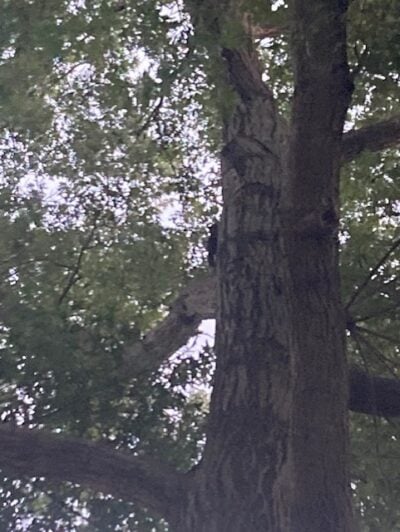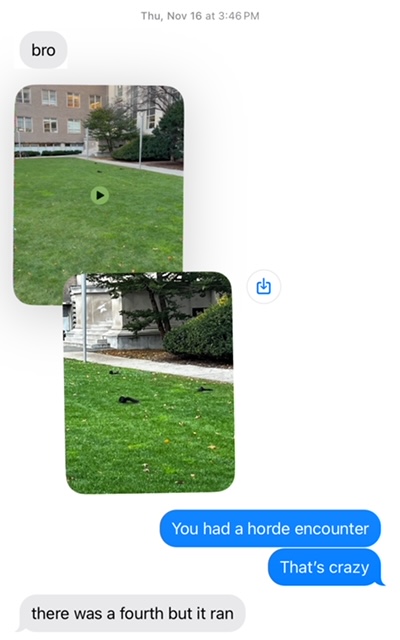
How Albatross Fly Without Flapping Their Wings, by Kayode D. '27
And other Lore™️ I learned this semester.
This blog is a long time coming. I initially anticipated making this on like week 3 to share some neat things I learned this semester and share some silly stories, but kept learning and experiencing things, so here’s a full semester’s worth of cool things, none of which are particularly applicable or useful, but there you go.
Albatross Lore
For a good portion of my time in 8.0101 Physics 1 I was failing. That’s why I dropped to 8.01L02 Physics 1 Long but that’s a story for another time. The thing I remember most from my time in 8.01 was something the professor taught us in the first few weeks. It has virtually no application to me or my life, and I will probably never use it as long as I live, but it was interesting to learn.
When he first introduced this topic, he claimed to have “a problem that had yet to be solved,” which immediately peaked my interest. This was the kind of thing I came to MIT to learn about!
This has to do with Albatross, a large bird with a 11 foot wingspan predominantly found in the southern hemisphere that spends 90% of its life in the air. An Albatross can go up to 6 years before returning to the island it was born on to mate and lay eggs. They hunt, eat, and sleep, all while in the air, occasionally landing in the water. But somehow, despite spending most of their lives in the air, Albatross don’t flap their wings.
This isn’t even the craziest part– Pterodactyls and Quezocatlus, two prehistoric flying dinosaurs the size of giraffes with wingspans up to 36 feet wide, were thought to have flown the same way! So how did they do it?
By gliding, or rather, “Dynamic Soaring”. Winds over the ocean are stronger, and by flying in a zig-zagging pattern, Albatross can use updrafts to gain speed and height. Using their large wingspans as a sort of sail, and angling the feathers on each wing’s end to turn, Albatross can gain lots of momentum and fly long distances without using much energy at all. And by locking their wings, they can rest and sleep in the air, meaning they can spend years without having to go to dry land.
If this method of flight could be harnessed in a drone or flying vehicle, large distances could be traveled without using much fuel. I just thought this was a really cool thing that I didn’t know about before MIT.
The Black Squirrel Situation:
After sharing my neat albatross facts at a blogger meeting early in the semester, I left the admissions office for the long trek back to Simmons Hall. I walked and talked with Amber V., and she shared some of the early developments of her 2.009 project. After splitting at a fork in the road, I saw something on a tree on Massachusetts Avenue, outside of the main campus building.
It was a black squirrel. I was shocked! I immediate thought was “huh, it’s like a shiny pokemon03 Shiny Pokemon are variations of regular pokemon found in the pokemon games with alternate colors and a shiny glimmer surrounding them. They're super rare, with like a 1/8192 chance of encountering one. Basically its a rare pokemon. “. I had never seen a black squirrel before, and started to wonder if it was like an albino animal and was extremely rare. I almost pulled out my phone to take a picture, but decided not to. It’s only a black animal, and cats and dogs are black all of the time! Also, my phone was at 3% battery and I didn’t want to waste its last few moments taking a picture of a common animal. I watched it scamper away up the tree.
And then curiosity got the best of me and I looked up how rare it was. I’d seen grey and brown squirrels in Kentucky, and for some reason a black squirrel just looked so odd to me.
1 in 10,000. Black squirrels are 1 in 10,000. A .01% chance of spotting one and I didn’t take a picture! They’re also only found in northern areas, which explains why I hadn’t seen any before in Kentucky. I frantically swapped to the camera app and took this blurry picture of a black blob on a tree branch:

This is my furry blob of a black squirrel.
I got back to my dorm and texted the admissions groupchat to tell this story, and was informed about how common they were on MIT Campus. But somehow, despite how “common” they are, I have yet to see another black squirrel in all of my time here. I’ve seen a lot of rabbits and some gray squirrels but not a single black one. My friends don’t let me forget this, and text me photos and videos whenever they see one, just to rub it in.
The Fosbury Flop
This is something I learned in my NEW physics class, 8.01L (Physics LONG), and I thought it was really cool. It’s a technique for high jump that involves arching the back so that the jumper’s centre of mass travels underneath the high jump bar.
This is the video we watched in class and I think it does a better job explaining the Fosbury Flop than I ever could.
Rapid Fire Lore that I think is cool but wouldn’t commit a whole section to:
- Microwaves are the size that they are because that is the size of a Microwave. Like, the wavelength of the microwave that heats up you food wouldn’t do it’s job if you made the microwave bigger.
- Pineapple has flesh-eating enzymes in it that eat proteins off of your tongue, and this can make it feel like it’s burning your mouth. That, or MIT pineapple is just really, REALLY sour.
- In swimming, there’s a competition category called “Freestyle” where you can use any officially-regulated swimming technique you want. I didn’t know this because everyone uses the same technique, called the front stroke. I figured this was just called the freestyle technique, but no, it’s called the front crawl and is the fastest swimming technique, so everyone just uses it. (I learned this in my swim class)
- The idea of “No Elbows on the Table!” stems from when tables only had middle supports, and leaning on the edge would cause the table to flip over. So when my dad scolded 8-year-old me in a Chili’s, I should’ve just flipped the table on him.
- Horse feet are just fingers. The hoof is just like the last link of your middle finger, except it’s much bigger on a horse. Horses are born with hooves, and over time they turn into the kind you see on adult horses, although they initially don’t look anything like it. If you look up “baby horse feet” you can see it for yourself (it’s like if your fingers each had 20 fingers at the end).
SPREADING MISINFORMATION ON THE INTERNET ALERT!!!
Please take this with a grain of salt. I heard this 5th hand and now run the risk of spreading misinformation on the internet. It just sounded like a really cool thing and wanted to share:
Cambridge has a higher rabbit population than one would expect, and I see rabbits just about every day on my walk to classes in the mornings.
Apparently (and I looked and could find NO evidence to support this claim!) MIT’s main campus and Massachusetts Avenue is so massive that they act as an evolutionary barrier for rabbits, and the physical separation results genetic drift between the east campus and west campus rabbits. Apparently this was a UROP done by someone in the past, but I have yet to find any evidence to back up my unsubstantiated claim.
But think about it– have you ever seen a rabbit cross Mass Ave? Just consider it a Rock Fact!
Anyways, that’s a whole semester of Lore™️ that will never benefit me in any meaningful way or contribute to society! Now don’t ask me about molecular orbital theory or how to build a buffer, because I definitely don’t remember.
- Physics 1 back to text ↑
- Physics 1 Long back to text ↑
- Shiny Pokemon are variations of regular pokemon found in the pokemon games with alternate colors and a shiny glimmer surrounding them. They're super rare, with like a 1/8192 chance of encountering one. Basically its a rare pokemon. back to text ↑






